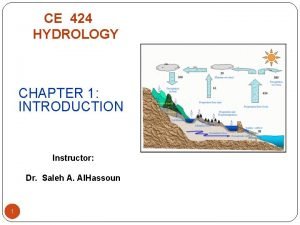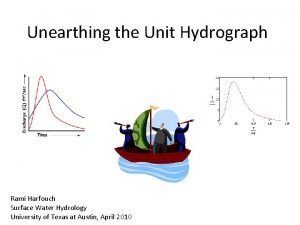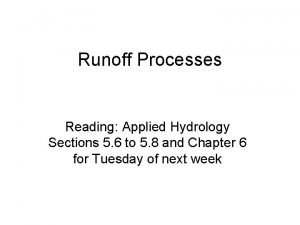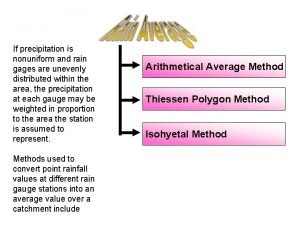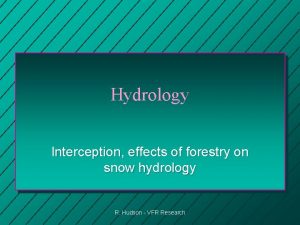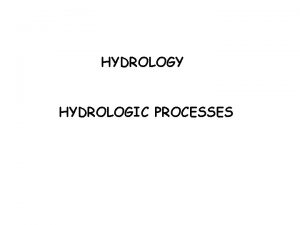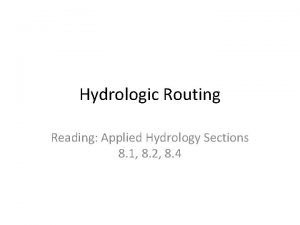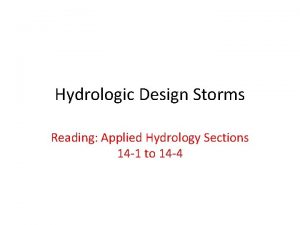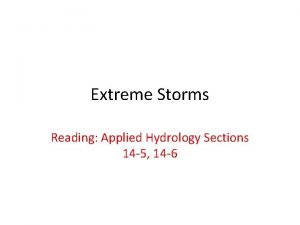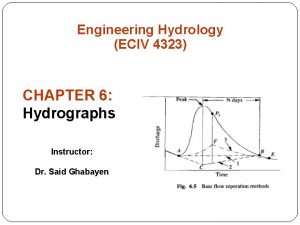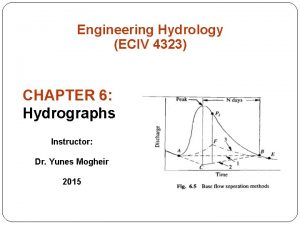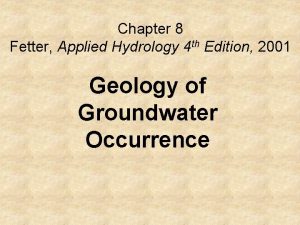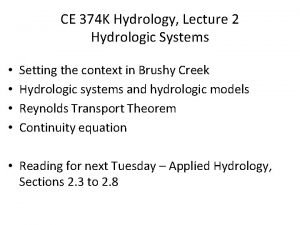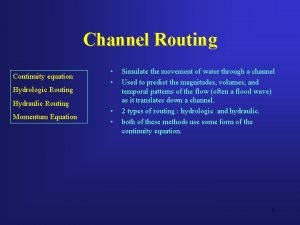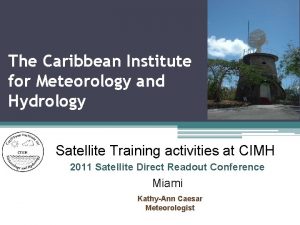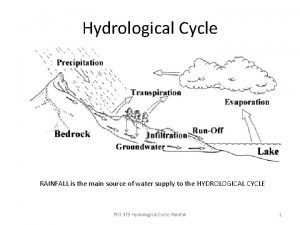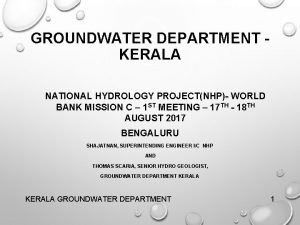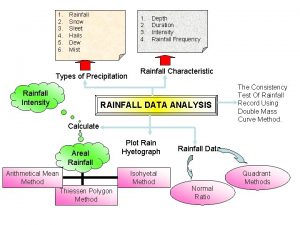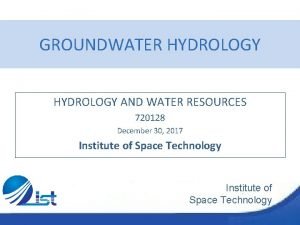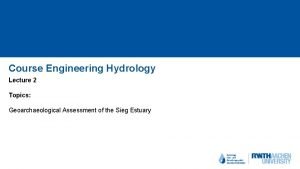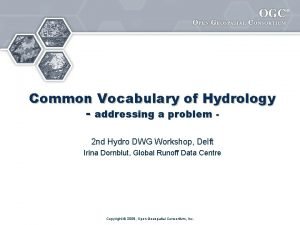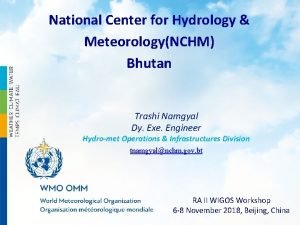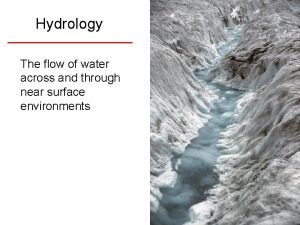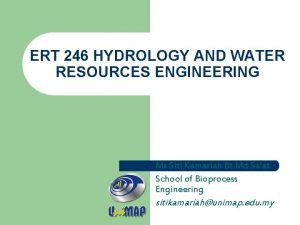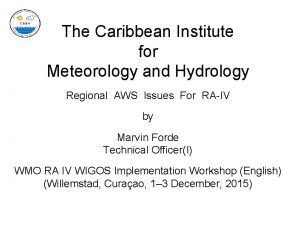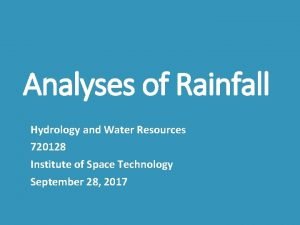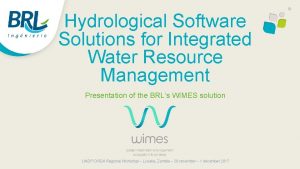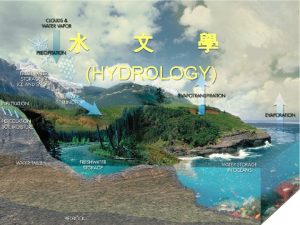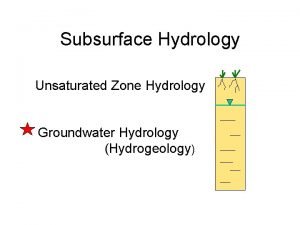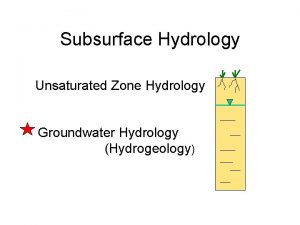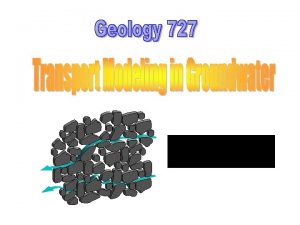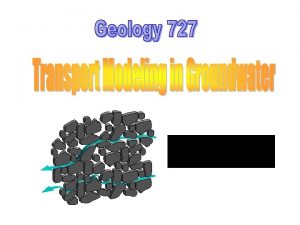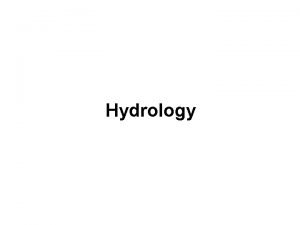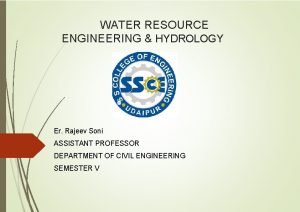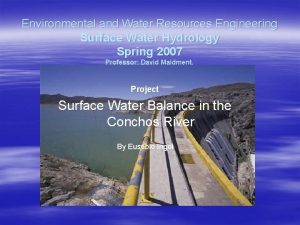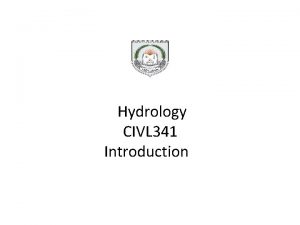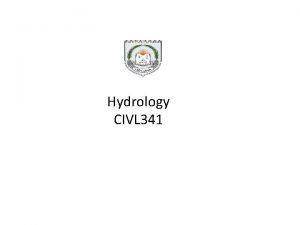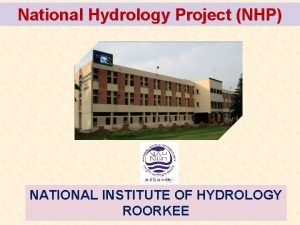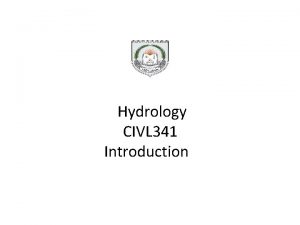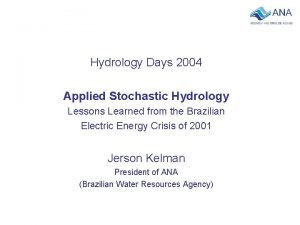WATER RESOURCE ENGINEERING HYDROLOGY ER RA JE E











































- Slides: 43

WATER RESOURCE ENGINEERING & HYDROLOGY ER. RA JE E V S ONI ASS ISTAN T P ROFESSO R DE PA RTME NT O F CIV IL ENGINEERING SEMES TE R VII

PRECIPITATION SSCE DEPARTMENT OF CIVIL ENGINEERING 2

DEFINITION All types of moisture reaching the surface of earth from atmosphere. . Precipitation is the basic input to the hydrology Factors determining precipitation or the amount of atmospheric moisture over a region Climate Geography Ocean surfaces is the chief source of moisture for precipitation SSCE DEPARTMENT OF CIVIL ENGINEERING 3

MECHANISM OF PRECIPITATION There are different kinds of precipitation : CONVECTIONAL: In this process, a fluid is heated by a warm surface , expands and rises creating an upward flow. Convectional precipitation results from the heating of the earth's surface. As the air warms the air becomes "lighter” and rises rapidly into the atmosphere. SSCE DEPARTMENT OF CIVIL ENGINEERING 4

(2) OROGRAPHIC : Orographic precipitation results when warm moist air moving across the ocean is forced to rise by large mountains. As the air rises, it cools at higher elevation results in cooler temperatures and deeper clouds. SSCE DEPARTMENT OF CIVIL ENGINEERING 5

CYCLONIC OR FRONTAL PRECIPITATION Cyclonic or Frontal precipitation results when the leading edge of a warm, moist air mass(warm front) meets a cool The warmer air mass is forced up over the cool air. As it rises, the warm air cools, the water vapour in the air condenses, and clouds and precipitation result. This type of system is called Frontal Precipitation because the moisture tends to occur along the front of the air mass. SSCE DEPARTMENT OF CIVIL ENGINEERING 6

FORMS OF PRECIPITATION SSCE DEPARTMENT OF CIVIL ENGINEERING 7

RAIN Rain is the most common type of precipitation in our atmosphere. Rain is when liquid droplets fall to the surface of the Earth. � There are two different forms of rain, either in the form of � � showers drizzles Showers are heavy, large drops of rain and usually only last a period of time. Drizzles however usually last longer and are made up of smaller droplets of water. � Rain can either be formed as ice crystals melt or it can be smaller water droplets. � SSCE DEPARTMENT OF CIVIL ENGINEERING Light I = 2. 5 mm/hr Moderate I = 2. 6 -7. 5 mm/hr Heavy I > 7. 5 mm/hr 8

SNOW Snow is the second most common precipitation in the North East. Snow forms when water vapor turns directly into ice without ever passing through a liquid state. This happens as water condenses around an ice crystal. Density of varies between snow required of liquid water Average gravity) = 0. 1 freshly to fallen 125 -500 mm equal density SSCE DEPARTMENT OF CIVIL ENGINEERING snow of 25 mm (specific 9

HAIL Hail is created when moisture and wind are together. Inside the cumulonimbus clouds ice crystals form, and begin to fall towards the surface of Earth. When this starts to happen wind gusts start to pick up the ice crystals pushing them up high into the clouds. As they start to fall down again they continue to grow in size. A wind gust might catch the hail stone again which will push it back up into the cloud. This whole process gets repeated several times before the hail stone becomes so big that it is too heavy for the wind to carry so it must fall towards Earth. Shapes of hail particles 1. Spherical 2. Conical 3. Irregular Diameter range 5 to 125 mm Specific gravity = 0. 8 Average density (specific gravity) = 0. 1 SSCE DEPARTMENT OF CIVIL ENGINEERING 10

FOG There is really no different between fog and the clouds that are high in the sky. In simple terms fog is a cloud that has formed near the surface of the Earth. There are four main types of fog, radiation fog advection fog upslope fog evaporation fog SSCE DEPARTMENT OF CIVIL ENGINEERING 11

DEW The small drops of water which can be found on cool surfaces like grass in the morning. This is the result of atmospheric vapor condensing on the surface in the colder night air. Dew Point is the temperature in which condensation starts to take place or when dew is created. SSCE DEPARTMENT OF CIVIL ENGINEERING 12

MIST / DRIZZLE � Mist is a bunch of small droplets of water which are in the air. This occurs with cold air when it is above a warm surface, for example water. � Fog and mist are very similar, the only difference is their visibility. � If you cannot see 1 kilometer or less you know you're dealing with fog. � You can see visuals through mist and it is more haze looking than a thicker substance. Diameter range between 0. 1 and 0. 5 mm/hr SSCE DEPARTMENT OF CIVIL ENGINEERING 13

GLAZE Glaze is the ice coating, generally clear and smooth, formed on exposed surfaces by the freezing of super cooled water deposited by rain or drizzle. Specific gravity may be as high as 0. 8 -0. 9 SSCE DEPARTMENT OF CIVIL ENGINEERING 14

RIME Rime is the white opaque deposit of ice granules more or less separated by trapped air and formed by rapid freezing of super cooled water drops impinging on exposed objects. Specific gravity may be as low as 0. 2 -0. 3 SSCE DEPARTMENT OF CIVIL ENGINEERING 15

SLEET Sleet consists of transparent, globular, solid grains of ice formed by the freezing of raindrops or freezing of largely melted ice crystals falling through a layer of sub freezing air near the earth’s surface. SSCE DEPARTMENT OF CIVIL ENGINEERING 16

SSCE DEPARTMENT OF CIVIL ENGINEERING 17

MEASUREMENT OF PRECIPITATION Rainfall and other forms of precipitation are measured in terms of depth, the values being expressed in millimeters and 10 th of millimeters. One millimeter of precipitation represents the quantity of water needed to cover the land with a 1 mm layer of water, taking into account that nothing is lost through drainage, evaporation or absorption. Instrument used to collect and measure the precipitation is called rain gauge. SSCE DEPARTMENT OF CIVIL ENGINEERING 18

MEASUREMENT OF PRECIPITATION 1. Amount of precipitation 2. Intensity of precipitation 3. Duration of precipitation 4. Arial extent of precipitation SSCE DEPARTMENT OF CIVIL ENGINEERING 19

MEASUREMENT METHODS �Measurement of precipitation (Rain and Snow) can be done by various devices. These measuring devices and techniques are : �Rain Gauges �Snow Gauges �Radars �Satellites �Scratching of snow packs �Water equivalent in snow packs SSCE DEPARTMENT OF CIVIL ENGINEERING 20

RAIN GAUGES Rain gages are most commonly used for the measurement of precipitation, both in terms of rain fall and snow. The rain gauge is also known as hyeto meter. Rain gauges have been used historically to provide rainfall quantities and rates at a single point in space The volume of water collected in a cylinder is divided by the area of the cylinder opening and converted into a depth or rain. SSCE DEPARTMENT OF CIVIL ENGINEERING 21

SSCE DEPARTMENT OF CIVIL ENGINEERING 22

TYPES OF RAIN GAUGES There are two main types of rain gages which are used to measure the precipitation. These are: 1. Non recording rain gages 2. Recording rain gages SSCE DEPARTMENT OF CIVIL ENGINEERING 23

NON RECORDING RAIN GAUGES These are basic storage devices that measure the cumulative amount of rain. A common type of these gauges is called the 8 -inch Standard Rain Gauge (SRG) which has been used by the weather offices of US National Weather Service (NWS) for over 100 years. The standard gauge is simply a large cylinder with a funnel and a plastic measuring tube inside the cylinder. SSCE DEPARTMENT OF CIVIL ENGINEERING 24

The non-recording rain gauge used in India is the Symons's rain gauge. It consists of a funnel with a circular rim of 12. 7 cm diameter and a glass bottle as a receiver. The cylindrical metal casing is fixed vertically to the masonry foundation with the level rim 30. 5 cm above the ground surface. The rain falling into the funnel is collected in the receiver and is measured in a special measuring glass graduated in mm of rainfall; when full it can measure 1. 25 cm of rain. The rainfall is measured every day at 08. 30 hours IST. The collector is of size 100 to 200 cm. SSCE DEPARTMENT OF CIVIL ENGINEERING 25

During heavy rains, it must be measured three or four times in the day, lest the receiver fill and overflow, but the last measurement should be at 08. 30 hours IST and the sum total of all the measurements during the previous 24 hours entered as the rainfall of the day in the register. Usually, rainfall measurements are made at 08. 30 hr IST and sometimes at 17. 30 hr IST also. Thus the non-recording or the Symons rain gauge gives only the total depth of rainfall for the previous 24 hours (i. e. , daily rainfall) and does not give the intensity and duration of rainfall during different time intervals of the day. It is often desirable to protect the gauge from being damaged by cattle and for this purpose a barbed wire fence may be erected around it. 26 SSCE DEPARTMENT OF CIVIL ENGINEERING

RECORDING RAIN GAUGE This is also called self-recording, automatic or integrating rain gauge. This type of rain gauge has an automatic mechanical arrangement consisting of a clockwork, a drum with a graph paper fixed around it and a pencil point, which draws the mass curve of rainfall. From this mass curve, the depth of rainfall in a given time, the rate or intensity of rainfall at any instant during a storm, time of onset and cessation of rainfall, can be determined. The gauge is installed on a concrete or masonry platform 45 cm square in the observatory enclosure by the side of the ordinary rain gauge at a distance of 2 -3 m from it. The gauge is so installed that the rim of the funnel is horizontal and at a height of exactly 75 cm above ground surface. The self-recording rain gauge is generally used in conjunction with an ordinary rain gauge exposed close by, for use as standard, by means of which the readings of the recording rain gauge can be checked and if necessary adjusted. SSCE DEPARTMENT OF CIVIL ENGINEERING 27

TYPES OF RECORDING RAIN GAUGES There are three main types of recording rain gauges 1. Float type rain gauges 2. Tipping bucket type rain gauges 3. Weighing type rain gauges SSCE DEPARTMENT OF CIVIL ENGINEERING 28

FLOAT TYPE RAIN GAUGE In this type, as the rain is collected in a float chamber, the float moves up which makes a pen to move on a chart wrapped round a clock driven drum. When the float chamber fills up, the water siphons out automatically through a siphon tube kept in an interconnected siphon chamber. The clockwork revolves the drum once in 24 hours. The clock mechanism needs rewinding once in a week when the chart wrapped round the drum is also replaced. This SSCE DEPARTMENT OF CIVIL ENGINEERING 29

SSCE DEPARTMENT OF CIVIL ENGINEERING 30

The graphic rain gauge 1 -receiver 2 -floater 3 -siphon 4 -recording needle 5 -drum with diagram 6 -clock mechanism SSCE DEPARTMENT OF CIVIL ENGINEERING 31

�The rise of float with increasing catch of rainfall is recorded. Some gauges must be emptied manually while others are emptied automatically using self starting siphons. �In most gauges oil or mercury is the float and is placed in the receiver, but in some cases the receiver rests on a both of oil or mercury and the float measures the rise of oil or mercury displaced by the increasing weight of the receiver as the rainfall catch freezes. Float may get damaged by rainfall catch freezer SSCE DEPARTMENT OF CIVIL ENGINEERING 32

Disadvantages of float gauge : They are costlier than other non recording rain gauges Mechanical defects sometimes gives erroneous results SSCE DEPARTMENT OF CIVIL ENGINEERING 33

TIPPING BUCKET RAIN GAUGE This consists of a cylindrical receiver 30 cm diameter with a funnel inside. Just below the funnel a pair of tipping buckets is pivoted such that when one of the bucket receives a rainfall of 0. 25 mm it tips and empties into a tank below, while the other bucket takes its position and the process is repeated. The tipping of the bucket actuates on electric circuit which causes a pen to move on a chart wrapped round a drum which revolves by a clock mechanism. This type cannot record snow. SSCE DEPARTMENT OF CIVIL ENGINEERING 34

A tipping bucket rain gauge is used for measurement of rainfall. It measures the rainfall with a least count of 1 mm and gives out one electrical pulse for every millimeter of rainfall SSCE DEPARTMENT OF CIVIL ENGINEERING 35

Advantage of tipping bucket : it is the only recording gauge which can be used in remote places by installing the recorder at a convenient and easily accessible location Disadvantages of tipping bucket : If the bucket is designed to tip at a convenient frequency for a particular intensity of rainfall , they will tip either too soon or too late for other intensities SSCE DEPARTMENT OF CIVIL ENGINEERING 36

SSCE DEPARTMENT OF CIVIL ENGINEERING 37

WEIGHING TYPE RAIN GAUGE In this type of rain-gauge, when a certain weight of rainfall is collected in a tank, which rests on a spring-lever balance, it makes a pen to move on a chart wrapped round a clock driven drum. The rotation of the drum sets the time scale while the vertical motion of the pen records the cumulative precipitation. SSCE DEPARTMENT OF CIVIL ENGINEERING 38

SSCE DEPARTMENT OF CIVIL ENGINEERING 39

Disadvantages of weighing type rain gauge : in heavy precipitation there is good chance that bucket will overflow these instruments are costlier too Advantages of weighing type rain gauge : it can measure all forms of precipitation including snow and rain SSCE DEPARTMENT OF CIVIL ENGINEERING 40

LOCATION OF RAIN GAUGES The amount of rainfall collected by a rain gauge depends on its exposure conditions and there fore great care must be taken for selecting suitable site for a rain gauge. According to Indian standards the following precautions must be taken while selecting a site for a rain gauge station : 1) 2) 3) 4) The site should be on level ground, i. e, sloping ground, hill tops or hill slopes are not suitable The site should be an open space. Horizontal distance between the rain gauge and the nearest object should be twice the height of the object Site should be away from continuous wind forces. SSCE DEPARTMENT OF CIVIL ENGINEERING 41

5) Other meteorological object and the fencing of the site should maintain the horizontal distance between the rain gauge and the nearest object twice the height of object. 6) The site should be easily accessible. The gauge should be truly vertical. 10% of total number of rain gauge stations of any basin should be self recording. The observer must visit the site regularly to ensure its proper readiness for measurement. 7) 8) 9) SSCE DEPARTMENT OF CIVIL ENGINEERING 42

Thank you SSCE DEPARTMENT OF CIVIL ENGINEERING 43
 Water and water and water water
Water and water and water water A small catchment of area 150 ha
A small catchment of area 150 ha Meteorology hydrology and water management
Meteorology hydrology and water management Resource allocation vs resource leveling
Resource allocation vs resource leveling Perbedaan resource loading dan resource levelling
Perbedaan resource loading dan resource levelling Applied hydrology
Applied hydrology Applied hydrology
Applied hydrology Quadrant method hydrology
Quadrant method hydrology Hydrology test answers
Hydrology test answers Drh in hydrology
Drh in hydrology Interception hydrology
Interception hydrology Applied hydrology
Applied hydrology Hydrograph
Hydrograph Hyteograph
Hyteograph Applied hydrology
Applied hydrology The basic assumptions of the unit-hydrograph theory are
The basic assumptions of the unit-hydrograph theory are Drh in hydrology
Drh in hydrology Applied hydrology
Applied hydrology Continuity equation hydraulics
Continuity equation hydraulics Applied hydrology
Applied hydrology Pitot equation
Pitot equation Branches of hydrology
Branches of hydrology Continuity equation hydrology
Continuity equation hydrology Continuity equation hydrology
Continuity equation hydrology Caribbean weather satellite
Caribbean weather satellite Hydrology lecture
Hydrology lecture Brutsaert
Brutsaert Quadrant method hydrology
Quadrant method hydrology Hydrology department kerala
Hydrology department kerala Rainfall depth
Rainfall depth Design storm in hydrology
Design storm in hydrology بئر ارتوازي
بئر ارتوازي Hydrology
Hydrology International glossary of hydrology
International glossary of hydrology Nchm bhutan
Nchm bhutan Return flow in hydrology
Return flow in hydrology What is hydrology
What is hydrology In greek language hudor means *
In greek language hudor means * Caribbean institute for meteorology and hydrology
Caribbean institute for meteorology and hydrology Dad curve hydrology
Dad curve hydrology Advanced hydrology
Advanced hydrology Water resource management software
Water resource management software Importance of water resource management
Importance of water resource management Water resource technologies
Water resource technologies

